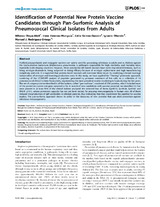Mostrar el registro sencillo del ítem
Identification of Potential New Protein Vaccine Candidates through Pan-Surfomic Analysis of Pneumococcal Clinical Isolates from Adults
| dc.contributor.author | Olaya-Abril, Alfonso | |
| dc.contributor.author | Jiménez-Munguía, I. | |
| dc.contributor.author | Gómez-Gascón, Lidia | |
| dc.contributor.author | Obando, Ignacio | |
| dc.contributor.author | Rodríguez-Ortega, Manuel J. | |
| dc.date.accessioned | 2017-12-01T08:26:40Z | |
| dc.date.available | 2017-12-01T08:26:40Z | |
| dc.date.issued | 2013 | |
| dc.identifier.uri | http://hdl.handle.net/10396/15622 | |
| dc.description.abstract | Purified polysaccharide and conjugate vaccines are widely used for preventing infections in adults and in children against the Gram-positive bacterium Streptococcus pneumoniae, a pathogen responsible for high morbidity and mortality rates, especially in developing countries. However, these polysaccharide-based vaccines have some important limitations, such as being serotype-dependent, being subjected to losing efficacy because of serotype replacement and high manufacturing complexity and cost. It is expected that protein-based vaccines will overcome these issues by conferring a broad coverage independent of serotype and lowering production costs. In this study, we have applied the ‘‘shaving’’ proteomic approach, consisting of the LC/MS/MS analysis of peptides generated by protease treatment of live cells, to a collection of 16 pneumococcal clinical isolates from adults, representing the most prevalent strains circulating in Spain during the last years. The set of unique proteins identified in all the isolates, called ‘‘pan-surfome’’, consisted of 254 proteins, which included most of the protective protein antigens reported so far. In search of new candidates with vaccine potential, we identified 32 that were present in at least 50% of the clinical isolates analyzed. We selected four of them (Spr0012, Spr0328, Spr0561 and SP670_2141), whose protection capacity has not yet been tested, for assaying immunogenicity in human sera. All of them induced the production of IgM antibodies in infected patients, thus indicating that they could enter the pipeline for vaccine studies. The pan-surfomic approach shows its utility in the discovery of new proteins that can elicit protection against infectious microorganisms. | es_ES |
| dc.format.mimetype | application/pdf | es_ES |
| dc.language.iso | eng | es_ES |
| dc.publisher | Public Library of Science | es_ES |
| dc.rights | https://creativecommons.org/licenses/by-nc-nd/4.0/ | es_ES |
| dc.source | PLoS ONE 8(7): e70365 (2013) | es_ES |
| dc.subject | Pneumococcus | es_ES |
| dc.subject | Vaccines | es_ES |
| dc.subject | Cell walls | es_ES |
| dc.subject | Membrane proteins | es_ES |
| dc.subject | Conjugate vaccines | es_ES |
| dc.subject | Lipoprotein secretion | es_ES |
| dc.subject | Serine proteases | es_ES |
| dc.subject | Transmembrane transport proteins | es_ES |
| dc.title | Identification of Potential New Protein Vaccine Candidates through Pan-Surfomic Analysis of Pneumococcal Clinical Isolates from Adults | es_ES |
| dc.type | info:eu-repo/semantics/article | es_ES |
| dc.relation.publisherversion | http://dx.doi.org/10.1371/journal.pone.0070365 | es_ES |
| dc.relation.projectID | Gobierno de España. SAF2008-00733 | es_ES |
| dc.relation.projectID | Junta de Andalucía. P09-CTS-4616 | es_ES |
| dc.relation.projectID | Junta de Andalucía. PI-0207-2010 | es_ES |
| dc.rights.accessRights | info:eu-repo/semantics/openAccess | es_ES |

